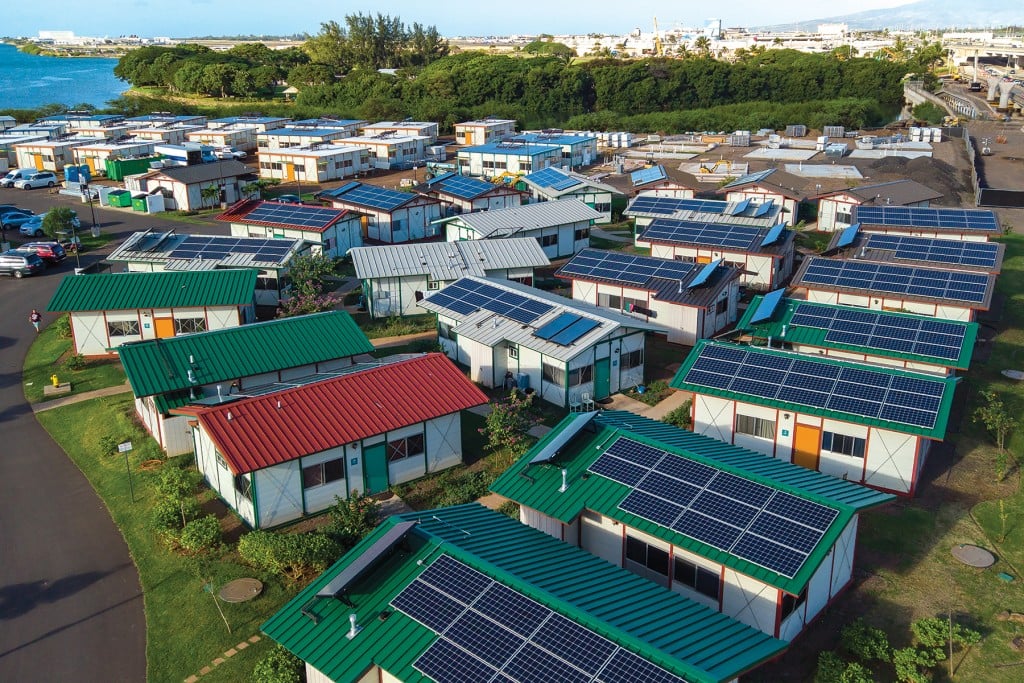Microgrids: A Different Way to Deliver Power - Hawaii Business Magazine (original) (raw)

Imagine an electric grid that keeps your lights on while the rest of the island’s grid is dark during a natural disaster or outage.
That’s the promise at Kahauiki Village, a community for formerly homeless families near Sand Island. The village has its own independent power grid, or microgrid, that’s powered by solar panels, a battery and a backup generator. The village only draws power from the utility when there’s not enough sunlight and battery charge to meet its energy needs, so its microgrid operates off the islandwide grid 98% of the time, says Paul Orem, CEO of PhotonWorks Engineering, which delivered the village’s electrical infrastructure. The backup generator is used as a last resort, when the utility grid is down.
Microgrids can take a variety of forms but are not a new concept. Ted Borer, a board member of the Microgrid Resources Coalition and energy plant director at Princeton University, says microgrids existed in the U.S. in the late 1800s when there were no interconnecting electric utilities. Newer technology has refined them with better materials, digital controls and the ability to run faster, he says, and people use them today for their potential to provide added reliability, independence, cost savings and resiliency.
The state Public Utilities Commission, Hawaiian Electric Cos., Microgrid Resources Coalition, Distributed Energy Resources Council of Hawaii, Ulupono Initiative and three others are working to create a microgrid services tariff to encourage microgrid development in the Islands. The Public Utilities Commission proceeding was opened in response to a 2018 state law and will address several issues, including the rules for microgrids to interconnect with the Hawaiian Electric grids and the value of microgrid benefits and services.
Marc Asano, director of transmission and distribution and interconnection planning at Hawaiian Electric Co., says the utility’s goal is to create a tariff that encourages a more resilient grid.
“We want to encourage development of resources that can power the grid during grid outages or if some natural disaster were to hit and our infrastructure would not be able to withstand that, that we can still deliver a level of service especially to critical loads on the island,” he says. Critical loads include hospitals, police stations, military bases and other facilities that must always be powered. “But how we get there is part of what’s getting discussed in the docket.”
What is a Microgrid?
There are several ways to define a microgrid.
Ted Peck, a member of the Distributed Energy Resources Council’s steering committee and president of Holu Hou Energy, says a microgrid consists of on-site generation that can meet all or part of a user’s electricity needs and is dispatchable, which means it can be controlled as to how much and when it meets loads. Under his definition, a house with solar panels and batteries can be considered a microgrid.
“For simplicity sake, that’s the essence of a microgrid,” he says, adding that other definitions are more complex and have additional elements.
Ken Aramaki, senior advisor for planning and technology at Hawaiian Electric Co., says microgrids generally include electricity users, generation, storage, controllers and a connection with the utility grid within a defined electrical area. He and other energy experts interviewed for this story emphasize that microgrids should also be able to operate both as part of an island’s utility grid during normal operations and independently during emergencies and power outages. They say these functions are key defining elements of microgrids.
Lisa Laughner, CEO and co-founder of Go Electric, says microgrids can consist of a variety of resources such as solar panels, generators, fuel cells, water heaters and batteries. Go Electric is an Indiana-based energy technology company that deployed a microgrid at the military’s Camp Smith on O‘ahu and is building another at Parker Ranch on Hawai‘i Island.
“Microgrids come in all kinds of shapes and sizes and are very dependent upon the site, the facility that you’re powering, as to what’s the best design,” Peck says. “There’s no one size fits all for microgrids.”
Added Resiliency
Microgrids provide increased resiliency through several means: by locating electricity generation close to the electrical users and needs they serve and by their ability to operate independently of the utility’s grid.
Distributed energy resources like solar and batteries typically turn off during a grid outage, Laughner says, because they can’t safely operate.
“That was one of the shocking things that a lot of customers found out in Puerto Rico after (Hurricane) Maria went through and the grid was out,” Laughner says. “They thought solar would continue to work and it didn’t. It turned off. … A microgrid accommodates to inverters, it keeps everything operating smoothly, so now your batteries and your PV are part of your resiliency solution to keep you powered up when the grid’s out.”
Microgrids at Camp Smith, the Schofield Barracks Generating Station and the Daniel K. Inouye International Airport emergency facility all can operate independently if the larger power grid fails.
Microgrids are also being discussed for other areas, including North Kohala on Hawai‘i Island and the Kalaeloa area on O‘ahu. The Natural Energy Laboratory of Hawaii Authority is working to develop a microgrid on its research campus in Kona.
“I think the way we look at microgrids is that they are a new solution in our large toolbox of resources and so now when we look at new projects where we need additional transmission lines for generating sources to serve remote loads, such as North Kohala, one of the alternatives that we’re looking at is a microgrid,” Aramaki says.